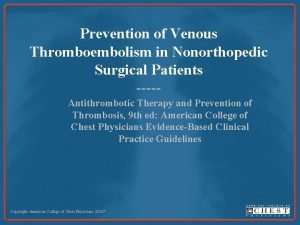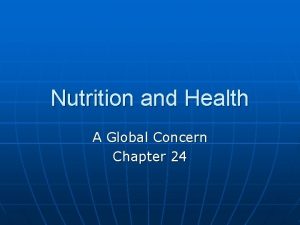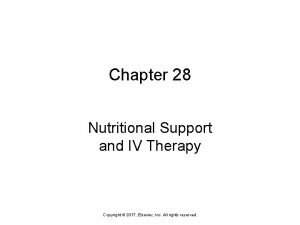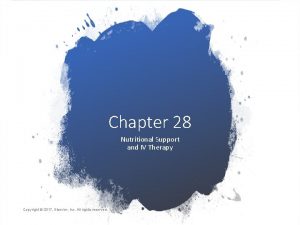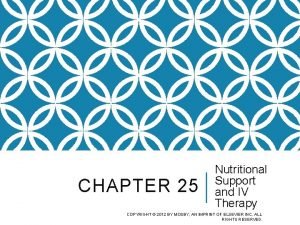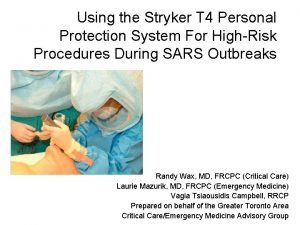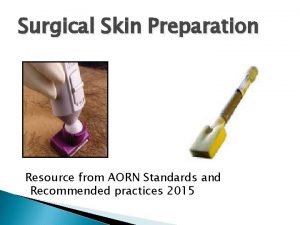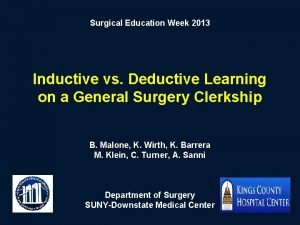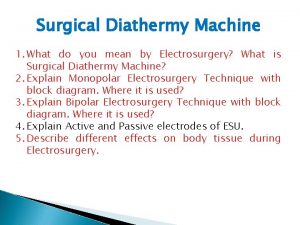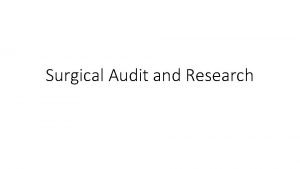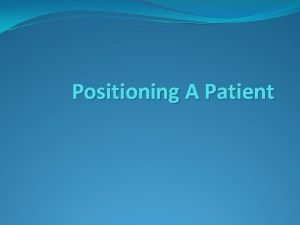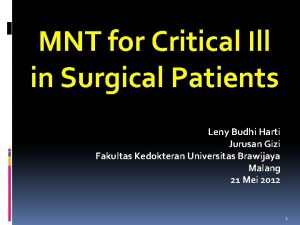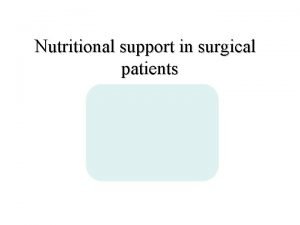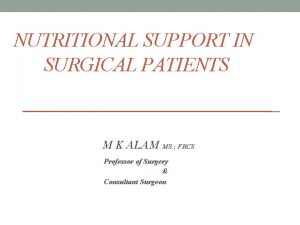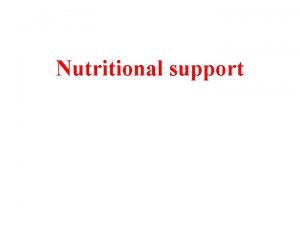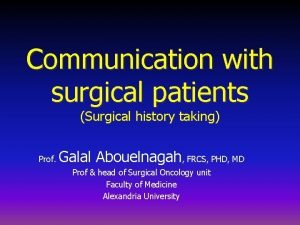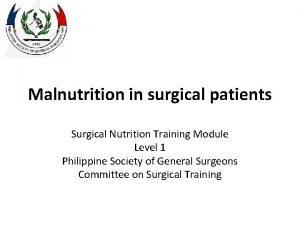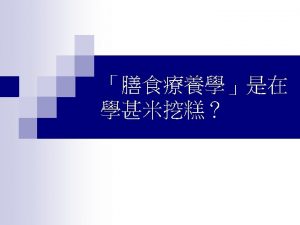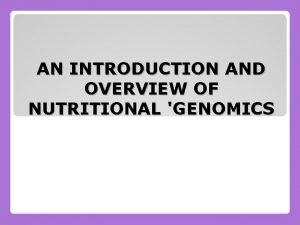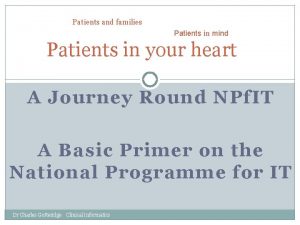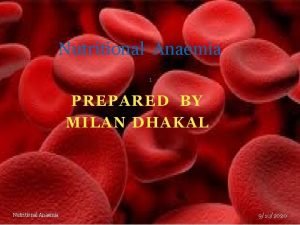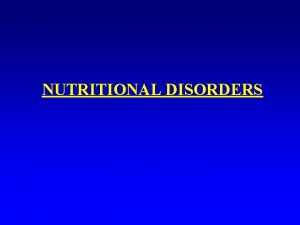NUTRITIONAL SUPPORT IN SURGICAL PATIENTS INTRODUCTION n Nutritional
















- Slides: 16

NUTRITIONAL SUPPORT IN SURGICAL PATIENTS

INTRODUCTION n Nutritional disorders in surgical patients have 2 principal components n n Starvation – effect of the disease, restriction of oral intake, or both Metabolic effects of stress/inflammation, increased catabolism, decreased anabolism

ASSESSMENT OF NUTRITIONAL REQUIREMENTS n n n ESTIMATION OF ENERGY AND PROTEIN REQUIREMENTS IN ADULT SURGICAL PATIENTS Uncomplicated Complicated/stressed Energy (Kcal/kg/day) 30 34 -40 Protein (g/kg/day) 1. 3 -2

CAUSES OF ADEQUATE INTAKE n n Patient with normal gut cumulative effects of repeated periods of fasting to undergo investigations such as endoscopy or contrast radiology. Patient with intestinal failure * Short bowel syndrome * Fistula formation * Motility disorders * Expensive small bowel disease(e. g. crohn’s disease)

CAUSES OF ANOREXIA IN SURGICAL PATIENTS n n n n INTESTINAL OBSTRUCTION ILEUS CANCER ANOREXIA DEPRESSION, STRESS, ANXIETY DRUGS e. g Opiates ORAL ULCERATION/INFECTION GENERAL DEBILITY/WEAKNESS

METHODS OF ADMINISTRATION OF ENTERAL FEEDS n n n NASOGASTRIC OR NASOJEJUNAL TUBES GASTROSTOMY JEJUNOSTOMY

COMPLICATIONS OF ENTERAL NUTRITION n n n DIARRHOEA VOMITING DIFFICULTY IN PLACING THE TUBE

PARENTERAL NUTRITION n n INDICATION FOR TPN (Total Parenteral Nutrition) COMPOSITION OF TPN

STANDARD PARENTERAL NUTRITION REGIMEN n n n Non-protein energy Nitrogen Volume Sodium Pottasium Calcium Magnesium Phosphate Zinc Chloride Acetate Adequate vitamins and trace elements 2200 kcal 13. 5 g 2500 ml 115 mmol 65 mmol 10 mmol 9. 5 mmol 20 mmol 0. 1 mmol 113. 3 mmol 135 mmol

COMPLICATIONS OF TPN (Total Parenteral Nutrition) n n CATHETER PROBLEMS THROMBOPHLEBITIS INFECTION METABOLIC COMPLICATIONS

PERIPHERAL VEIN NUTRITION n n Lipid emulsion & Isotonic Solutions of Amino Acids infused into peripheral veins Less irritant than TPN Short term usage Complication with long term (Thrombophlebitis)

MONITORING OF NUTRITIONAL SUPPORT n n n DEFICIENCY STATES ASSESS THE ADEQUACY OF ENERGY PROTEIN PROVISION ANTICIPITATE COMPLICATION Pulse rate / Blood Pressure – regularly recorded Accelerate fluid Balance Chart Urine checked for glycosuria daily Body weight measured twice weekly Serum Urea &Electrolyte – daily F. B. C, L. F. T , Serum Albumin , Ca+, Magnesium, Phosphate – once or twice weekly Urine collected over one or two 24 hr periods each week for Nitrogen balance.

NUTRITIONAL SUPPORT IN SURGICAL PATIENTS Clinical Scenarios

n n 1)A 69 year old man presented with significant weight loss and change in bowel habit. A mass was felt per rectum and he underwent a difficult abdominoperineal resection, with some feacal contamination perioperatively. He has not passed flatus since the operation. Recovery is anticipated to take a long time. Discuss the method of feeding ?

n n 2) A 72 year old woman suffered a left sided cerebrovascular accident during an elective abdominal aortic aneurysm repair. Four weeks later she still has no gag reflex. It is anticipated that she will be unable to feed herself for sometime Discuss the method of feeding?

n n 3) A 71 year old man suffers increasing dysphagia over some months. He has a lower oesophageal carcinoma. It proves impossible to pass a nasogastric tube. He is malnourished and it is decided that he will need nutritional support before surgery. Discuss the method of feeding ?
 Prevention of vte in nonorthopedic surgical patients
Prevention of vte in nonorthopedic surgical patients Chapter 24 nutritional care and support
Chapter 24 nutritional care and support Continuous feeding vs bolus feeding
Continuous feeding vs bolus feeding Chapter 28 nutritional support and iv therapy
Chapter 28 nutritional support and iv therapy Chapter 28 nutritional support and iv therapy
Chapter 28 nutritional support and iv therapy Chapter 28 nutritional support and iv therapy
Chapter 28 nutritional support and iv therapy Chapter 8 lifting and moving patients
Chapter 8 lifting and moving patients Major and minor details
Major and minor details Amerigel post op surgical kit
Amerigel post op surgical kit Stryker surgical helmet
Stryker surgical helmet Vitamin surgical sieve
Vitamin surgical sieve Aorn vaginal prep
Aorn vaginal prep Surgical education week
Surgical education week Types of electrodes used in surgical diathermy machine.
Types of electrodes used in surgical diathermy machine. Surgical audit examples
Surgical audit examples Proctologic position used for
Proctologic position used for Mnt critically ill
Mnt critically ill
